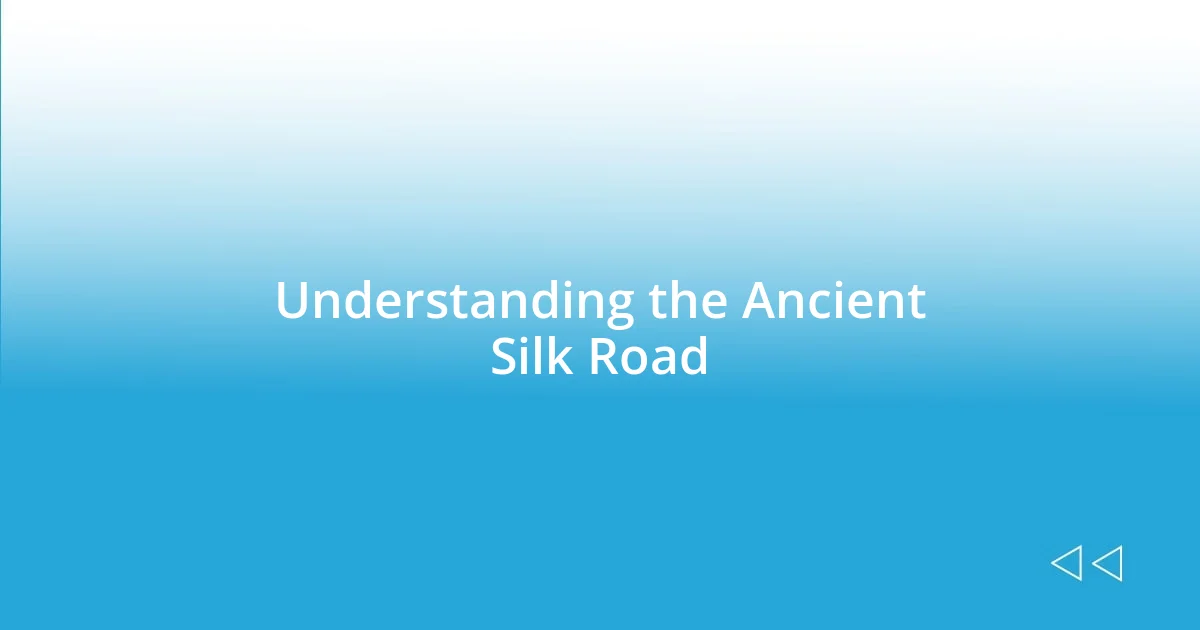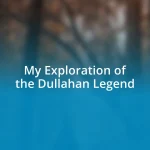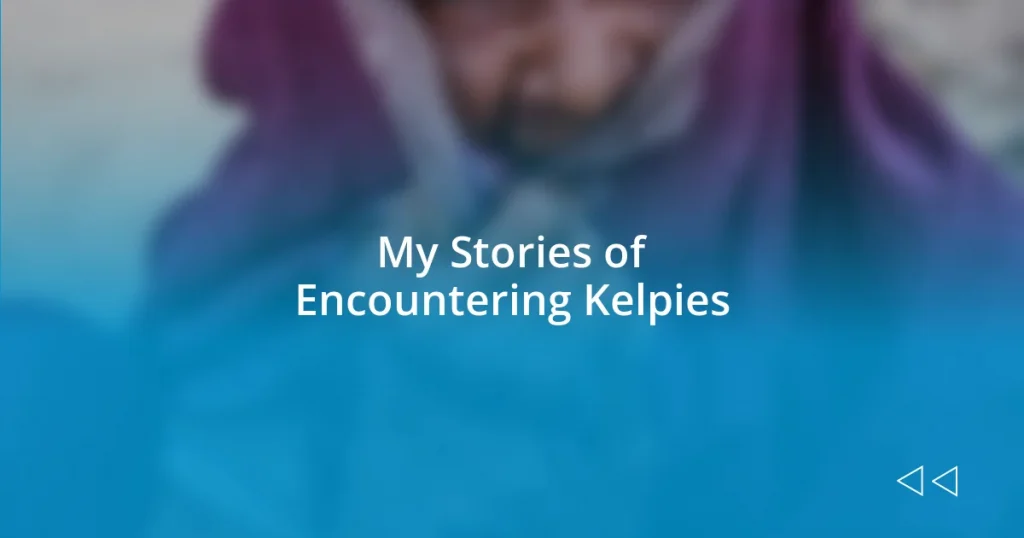Key takeaways:
- The Ancient Silk Road facilitated rich cultural exchanges among civilizations, impacting history through trade and shared experiences.
- Key destinations like Samarkand, Bukhara, and Xi’an offer unique cultural encounters, with each site steeped in history and community connections.
- Practical travel tips emphasize the importance of planning, language basics, and the value of spontaneity for an enriching travel experience.

Understanding the Ancient Silk Road
The Ancient Silk Road was not just a network of trade routes; it was a vibrant tapestry of cultures, ideas, and goods. As I wandered through the bustling bazaars mimicking those of centuries past, I couldn’t help but feel a connection to those early traders who bravely traversed vast deserts and treacherous mountains. What would it have been like to carry silk across such distances, knowing it might change hands multiple times before reaching its final destination?
The exchange of not only silk but also spices, gems, and even philosophies made the Silk Road a melting pot of civilizations. I often think about how connections formed here shaped the course of history. Imagine the conversations that took place over cups of tea, rich with the aroma of distant places and stories waiting to be told. Have you ever considered how a simple trade route could facilitate such profound exchanges between people who thought they would never meet?
Ultimately, the Silk Road was a symbol of human curiosity and resilience. There’s something awe-inspiring about the idea that traders were not solely focused on profit but also sought to share their heritage and learn from one another. Reflecting on that journey today, I find myself pondering: how much of our modern world is still woven from the threads of those ancient connections?

Planning Your Silk Road Journey
When I decided to embark on a journey along the Silk Road, I realized good planning was essential to maximize the experience. Research became my best friend as I pored over maps, travel blogs, and historical accounts. I discovered that it was essential to identify key stopping points, each rich with history and culture, making it easier to appreciate the journey rather than just the destination.
Here are some tips that helped me plan effectively:
- Research Destinations: Focus on major cities like Samarkand, Bukhara, and Xi’an, known for their unique sites and vibrant cultures.
- Understand Seasonal Variations: Timing your trip is crucial; the weather can dramatically change the experience.
- Learn Basic Local Phrases: A few words in the local languages can create connections and ease your travels.
- Pack Smart: Bring essential gear and consider the local customs to dress appropriately in each region.
- Be Flexible: Embrace the unexpected. Some of my favorite moments were spontaneous detours and local interactions.

Key Destinations Along the Route
When I first stepped foot in Samarkand, the vibrant blue tiles of Registan seemed to sing tales of ancient glory. I could almost hear the whispers of traders bargaining for silks and spices under the shadow of monumental buildings. This destination is not just a feast for the eyes; it’s where the past meets the present, and each corner I turned felt like I was walking through a living museum. Isn’t it fascinating how architecture can evoke such strong emotions and connections to history?
Bukhara, on the other hand, wrapped around me like a warm blanket. The intricate craftsmanship of its madrasahs and the bustling atmosphere of its bazaars made my heart race. I vividly recall sitting in a local tea house, sipping a fragrant brew while listening to stories from the elderly locals. Moments like these remind me how travel is as much about the people as it is about the places – the exchange of smiles and tales creates bonds that linger long after the journey ends.
Xi’an stands out in my memory for being the eastern terminus of the Silk Road, where the famed Terracotta Army resides. As I wandered among the soldiers, each uniquely crafted, I felt a profound sense of humanity and the weight of history. It’s captivating to think of the commitment and skill involved in creating such a long-lasting legacy. Wouldn’t you agree that these destinations along the Silk Road are more than just stops on the map? They are chapters in the ongoing story of human connection.
| Destination | Notable Features |
|---|---|
| Samarkand | Registan, vibrant bazaars, historical architecture |
| Bukhara | Madrasahs, tea houses, rich local storytelling |
| Xi’an | Terracotta Army, cultural significance, historical legacy |

Experiencing Local Cultures and Traditions
Experiencing local cultures along the Silk Road was nothing short of enchanting. One moment stands out vividly: while wandering the narrow streets of Bukhara, I stumbled upon a vibrant market bustling with life. The colors of the spices, the laughter of merchants, and the warmth of traditional Uzbek hospitality enveloped me, making me feel like a treasured guest rather than just a passerby. Isn’t it amazing how a simple marketplace can reflect the soul of a community?
In Xi’an, I had the opportunity to partake in a traditional dumpling banquet with locals. As I shared a table with families who had gathered to celebrate a special occasion, I felt an overwhelming sense of connection. The way they animatedly exchanged stories over plates of delicious dumplings reminded me that food isn’t just nourishment; it’s a language of love and tradition. Have you ever found yourself in a situation where a shared meal brought you closer to strangers?
The richness of local traditions became even more apparent at a festival I encountered in Samarkand. I had the chance to watch dancers in colorful attire performing ancient moves, their energy pulsating through the crowd. As I joined in, laughing and trying to mimic their steps, I realized how dance can transcend language—bridging cultures in joyous celebration. It left me wondering: is there anything more beautiful than feeling a part of something so deeply rooted in history?

Navigating Transportation Options
Navigating transportation along the Silk Road offers an adventure of its own. I remember standing at a bustling caravanserai in Central Asia, watching camels being loaded for another long journey. The sight reminded me that even in ancient times, the rhythm of trade depended heavily on these resilient animals, known for their stamina and ability to traverse vast, arid regions. Isn’t it intriguing how something as simple as an animal could shape trade routes and cultural exchanges?
As I ventured through the mountainous regions, I encountered local guides with their sturdy horses ready to assist travelers like me. Riding a horse across rugged terrain gave me a sense of connection to the past, as I imagined merchants and explorers making their way along the same paths centuries ago. I couldn’t help but smile at the bond I formed with my horse, who seemed to navigate the rocky ground like a seasoned traveler. Have you ever felt that exhilarating rush while riding through landscapes that tell stories of ages gone by?
When I reached the more urban areas, I found that modern transportation had started to blend with the ancient routes. Trains and buses provided efficient options, but my heart always longed for the nostalgic charm of the oxcarts in the small villages I passed through. I vividly recall sharing stories with locals during a slow ride, as their laughter filled the air, reminding me that sometimes, it’s about the journey as much as the destination. Don’t you think the way we travel creates unique memories that stay with us forever?

Practical Tips for Travelers
When planning your journey along the Silk Road, it’s crucial to pack light but wisely. During my travels, I learned the value of carrying versatile clothing that suits both hot and cooler climates. Trust me, that lightweight poncho saved me more times than I can count—from the desert sun to sudden mountain chills. Have you thought about how a single item can make such a difference in your comfort while traveling?
Language barriers can feel daunting, but I found that a smile often goes further than words. It was in a small town in Uzbekistan where I first attempted to speak a few local phrases. The sheer joy and laughter that erupted from the shopkeeper as I stumbled through my pronunciation made my day. It reminded me that effort means more than perfection. Why not try picking up basic phrases before your trip? You might be surprised by the connections you can forge.
Lastly, leave room in your itinerary for spontaneity. One evening in Kashgar, with no plans in mind, I wandered into an open square where a group of musicians began to perform. I found myself dancing with locals, and in that moment, I felt utterly alive. Sometimes, the unplanned experiences can transform your trip in ways that meticulously planned ones cannot. Have you ever let serendipity lead your adventures? The beauty of travel often lies just beyond the horizon of your original plans.
















